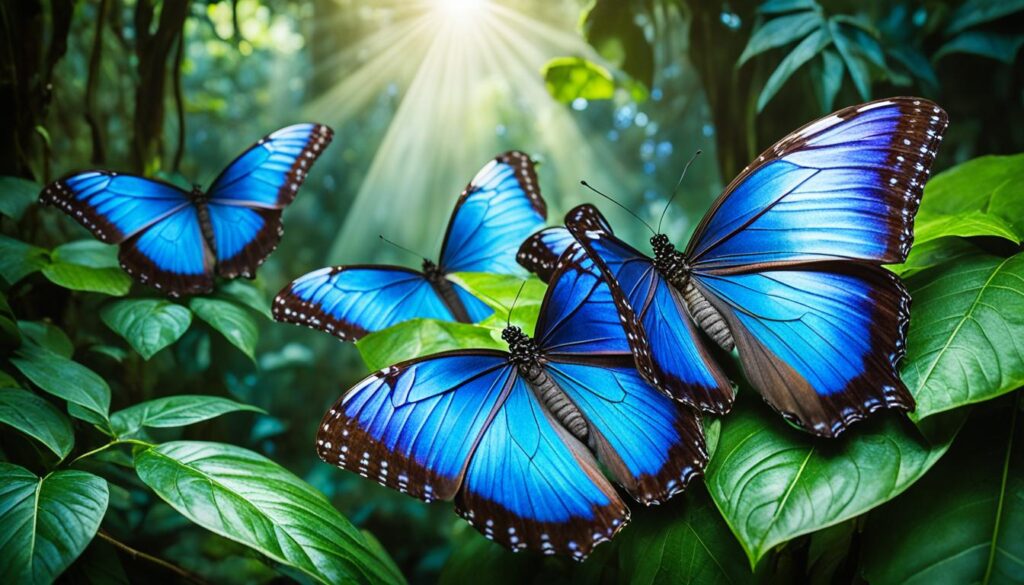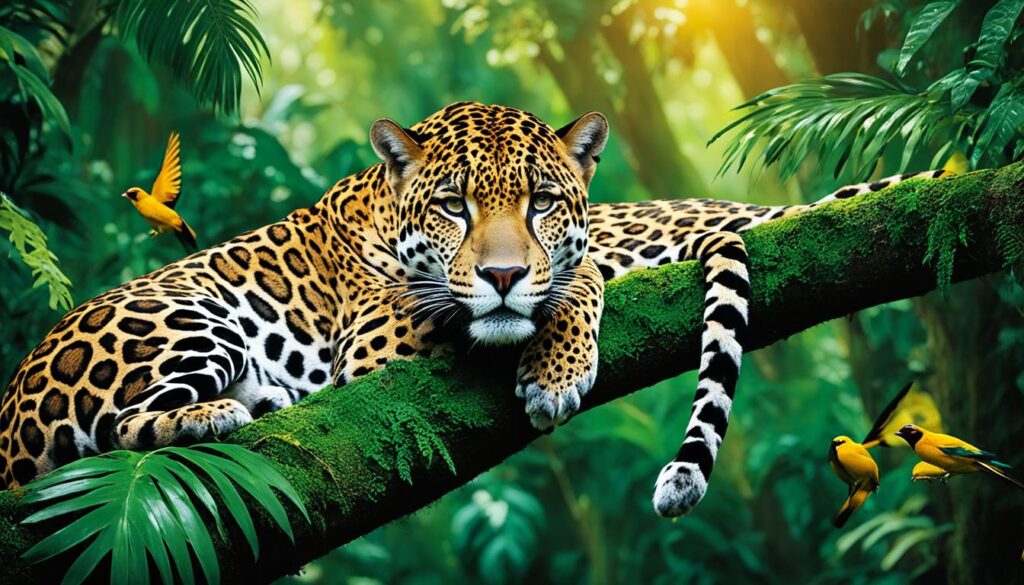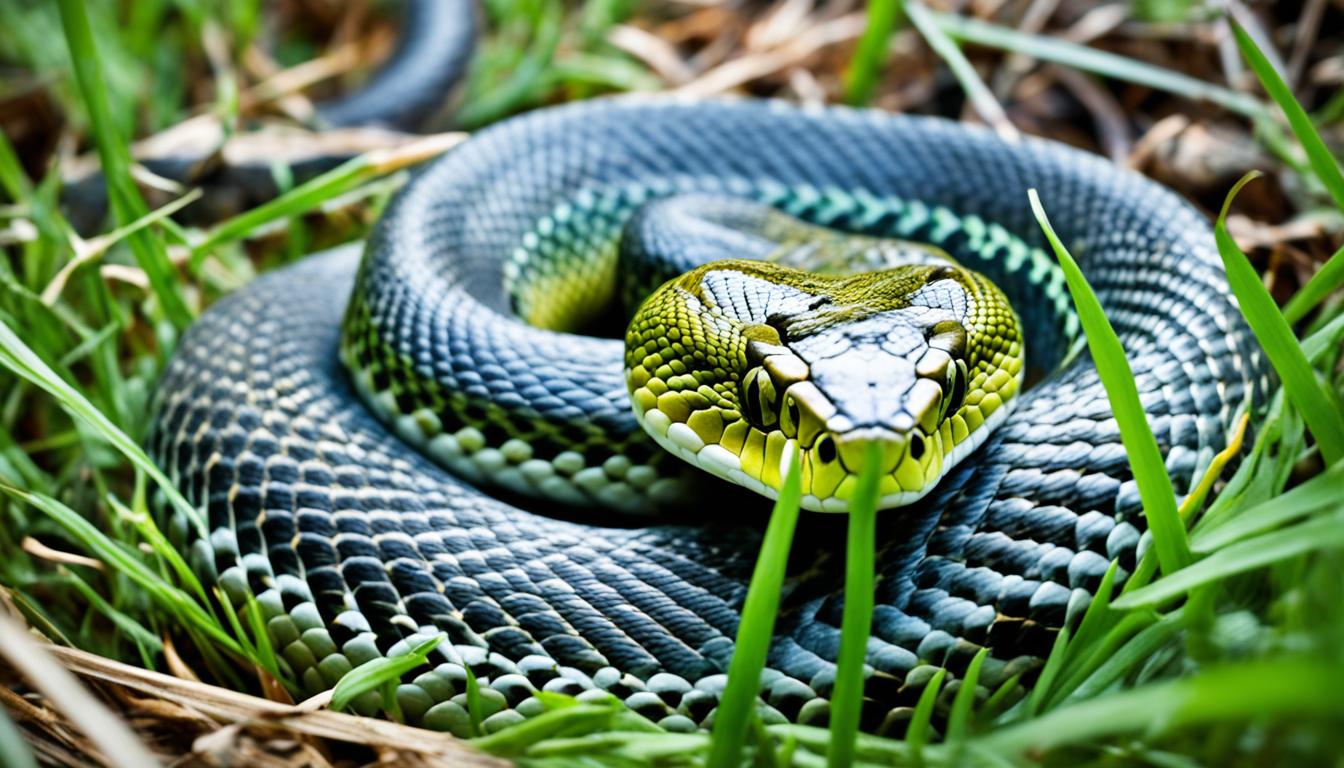Were you aware that rainforests harbor 80 percent of the world’s terrestrial biodiversity? These rich natural environments are filled with an incredible variety of wildlife, from magnificent primates to colorful parrots.
Key Takeaways:
- Rainforests are vital for the preservation of forest animals and overall biodiversity.
- Mountain gorillas are the largest living primates and are found in Central Africa.
- Blue morpho butterflies are brilliant beauties known for their camouflage techniques.
- Okapi, the elusive relative of giraffes, thrives in the dense Ituri Forest.
- Sloths are slow-moving tree dwellers that have algae growing on their fur.
Mountain Gorillas – The Majestic Primates of Central Africa
Mountain gorillas are the largest living primates on earth and share a close genetic similarity with humans. These magnificent creatures thrive in the lush rainforests of Central Africa, particularly in national parks located in Rwanda, Uganda, and the Democratic Republic of Congo. Living in groups of around 30 members, they form tight-knit social structures.
At the heart of each gorilla group is a dominant male known as the “silverback,” named for the silver-gray hairs on his back. The silverback leads and protects the group, ensuring the safety and well-being of its members.
Mountain gorillas are beautifully adapted to their forest habitat, with a robust build and muscular arms that help them navigate through dense vegetation. Their intelligence and gentle nature have captivated researchers and wildlife enthusiasts alike, leading to dedicated conservation efforts to protect their endangered populations.
It is a privilege to encounter these majestic primates in the wild, observing their behavior and witnessing their strong family bonds. Their conservation is of utmost importance to preserve the biodiversity of the rainforest ecosystems they call home.
| Feature | Description |
|---|---|
| Size | Mountain gorillas can reach heights of up to 5.6 feet (1.7 meters) when standing upright and weigh anywhere from 300 to 485 pounds (135 to 220 kilograms). |
| Location | Rwanda, Uganda, and the Democratic Republic of Congo. |
| Population | As of 2018, it is estimated that there are approximately 1,063 mountain gorillas left in the wild. |
| Conservation Status | Endangered. Mountain gorillas face various threats, including habitat loss, poaching, and disease. |
Unique Characteristics of Mountain Gorillas
- Thick fur helps protect them from the cold and wet forest environment.
- They have large, expressive eyes and a broad face.
- Using their opposable thumbs, they can grasp objects and manipulate their environment.
- Mountain gorillas primarily feed on plant matter, such as leaves, stems, and fruits.
- They exhibit a wide range of vocalizations and non-verbal communication, including chest-beating displays and elaborate grooming rituals.
Blue Morpho Butterflies – Brilliant Beauties of the Rainforest Canopy
Blue morpho butterflies are known for their brilliant, iridescent blue wings. They flutter through the rainforest canopy, captivating the eyes of anyone lucky enough to witness their breathtaking beauty. But these mesmerizing creatures have more to them than meets the eye. They possess unique adaptations that enable them to thrive in their rainforest habitat.

One of the most remarkable features of blue morpho butterflies is their incredible camouflage abilities. While their dazzling blue wings catch the attention of onlookers, their brown undersides act as a clever disguise. These butterflies use the “eyespots” on their underside to trick predators into believing they are larger or more threatening than they actually are.
Blue morpho butterflies are masters of camouflage, blending in with their surroundings to evade potential threats.
The rainforest canopy provides the perfect backdrop for their camouflaging skills. The dappled sunlight filtering through the dense foliage creates a patchwork of shadows and lights, mimicking the patterns on their wings. This allows them to seamlessly blend in and become nearly invisible to predators.
Did You Know?
- Blue morpho butterflies are found in Central and South America, primarily in countries such as Brazil, Costa Rica, and Panama.
- The brilliant blue color of their wings is not caused by pigmentation but rather by microscopic scales that reflect the surrounding light.
- They are known for their graceful flight, soaring through the rainforest with delicate wings that span up to six inches wide.
The unique beauty and agility of blue morpho butterflies make them a testament to the wonders of the rainforest. Their ability to adapt and thrive in this intricate ecosystem showcases the incredible diversity of life that the rainforest holds. These brilliant beauties, hidden among the leaves, serve as a constant reminder of the awe-inspiring miracles nature has to offer.
| Blue Morpho Butterflies | Fact |
|---|---|
| Wingspan | Up to six inches wide |
| Camouflage | Masters of blending in with their surroundings |
| Habitat | Rainforest canopy in Central and South America |
| Flight | Graceful and captivating |
Okapi – The Elusive Relative of the Giraffe
The okapi, a unique forest animal, inhabits the dense tropical Ituri Forest of Central Africa. Being the closest living relative of the giraffe, it shares some fascinating characteristics with its towering cousin. One of the most remarkable abilities of the okapi is its mastery of camouflage, allowing it to blend seamlessly into its surroundings.
The okapi’s striking appearance is characterized by its distinctive striped hindquarters and brown hide. These features play a crucial role in helping the okapi blend into the filtered light of the forest, making it nearly invisible to predators and human observers alike.

The Ituri Forest, located in Central Africa, provides the perfect habitat for the okapi’s survival. This dense tropical rainforest offers abundant foliage and a complex ecosystem that the creature relies on for sustenance and shelter. The okapi’s camouflage allows it to move discreetly through the forest, making it particularly elusive and elusive.
Sloths – The Slow-Moving Tree Dwellers
Sloths are fascinating creatures that have adapted to a unique lifestyle in the forest. These slow-moving mammals spend their entire lives in trees, rarely descending to the forest floor. With their specialized bodies and behaviors, sloths have become the perfect tree-dwellers, seamlessly blending into their surroundings.
One of the most striking features of sloths is their slow pace. They move so slowly that algae often grows on their fur, which gives it a green tinge. This remarkable camouflage helps them remain hidden from predators and allows them to easily blend in with the leaves and branches of trees.
Sloths primarily feed on leaves, twigs, and fruit, which provide them with the nutrients they need to survive. The slow digestion process of their plant-based diet can take up to a month for a single meal to pass through their system, contributing to their overall sluggishness.
Despite their leisurely lifestyle, sloths have managed to find an ecological niche in the forest. Their slow movement and camouflage allow them to conserve energy and remain hidden from potential threats. They rely on their sharp claws and powerful arms to navigate the treetops and move between branches with ease.
“Sloths truly embody the art of patience and adaptation. Their slow-motion existence in the forest demonstrates the remarkable diversity of life and the many unique ways in which animals have evolved.”
Dr. Jane Peters, Wildlife Biologist
Whether hanging upside down or leisurely munching on leaves, sloths captivate researchers and nature enthusiasts alike. Their mysterious lifestyle in the treetops continues to fascinate scientists, who strive to uncover the secrets of these incredible forest dwellers.

Join us in the next section as we delve into the world of jaguars, the beautiful spotted predators of the forest.
Jaguars – Beautiful Spotted Predators of the Forest
Jaguars are magnificent creatures known for their distinctive, beautiful spotted coats. These forest predators possess a remarkable ability to blend seamlessly into their natural habitat of grasses, bushes, and trees in the rainforest. Their unique camouflage allows them to stalk their prey with precision and remain elusive to potential threats.
With their powerful bodies and strong jaws, jaguars are apex predators in the rainforest ecosystem. They are capable of taking down a variety of prey, including armadillos, capybara, deer, and birds. Their hunting prowess makes them an essential part of the forest food chain, helping to maintain a balance among the various species.
It is fascinating to note that jaguars are not just limited to their characteristic spotted coats. Some individuals exhibit a rare variation known as the all-black jaguar or black panther. This melanistic form lacks the typical spots and appears as a sleek, solid black feline. The black panther is a striking sight in the dense rainforest, exuding an air of mystery and power.

| Jaguars | Fact |
|---|---|
| Scientific Name | Panthera onca |
| Habitat | Rainforests, grasslands, swamps, and scrublands |
| Size | Up to 6 feet in length (excluding the tail) and weighing up to 200 pounds |
| Lifespan | Average of 12 to 15 years in the wild |
| Conservation Status | Near Threatened |
| Characteristic Feature | Distinctive rosette-shaped patterns on their coats |
Jaguars are not only powerful predators but also significant indicators of a healthy rainforest ecosystem. Their presence is essential for maintaining a balanced and thriving environment. Protecting the rainforest and its inhabitants, including these mesmerizing forest predators, is crucial for the long-term conservation of our planet’s natural heritage.
Capybara – The Largest Rodent of the Forest

The capybara, also known as Hydrochoerus hydrochaeris, holds the title for being the largest rodent on Earth. Weighing over 100 pounds, these gentle herbivores inhabit the dense vegetation surrounding water bodies in various regions of South America.
With their long, barrel-shaped bodies, blunt snouts, and webbed feet, capybaras are perfectly adapted to their semi-aquatic lifestyle. Their close relationship with water allows them to cool off, find refuge, and forage on the abundant vegetation that thrives in these habitats.
One fascinating adaptation of capybaras is their ability to hold their breath underwater for up to five minutes. This skill comes in handy when under threat from predators, as they can quickly leap into the water to seek safety.
Capybaras are highly social animals that live in groups, known as troops, which can consist of up to 40 individuals. These troops establish a hierarchical structure, with a dominant male leading the group and defending their territory.
The capybara’s diet primarily consists of grasses, aquatic plants, and forest vegetation. Their grazing habits contribute to the shaping of the landscapes they inhabit and aid in the dispersal of seeds, making them important ecosystem engineers.
Key Facts about Capybaras:
- Scientific Name: Hydrochoerus hydrochaeris
- Weight: Over 100 pounds (45 kilograms)
- Habitat: Forest vegetation surrounding water bodies
- Diet: Grasses, aquatic plants, and forest vegetation
- Adaptations: Webbed feet, ability to hold breath underwater, grazing habits
- Social Structure: Live in groups called troops
“Capybaras are fascinating creatures that thrive in the lush habitats of South America. Their size, adaptability to water, and social nature make them an intriguing species to study and appreciate.” – Wildlife Expert
Capybara Conservation Status:
The capybara is classified as a species of Least Concern by the International Union for Conservation of Nature (IUCN). Although they face threats from habitat loss and hunting in some areas, their widespread distribution and population numbers have remained relatively stable.
| Threats | Conservation Actions |
|---|---|
| Habitat loss due to deforestation | Protected areas and conservation initiatives |
| Illegal hunting for meat and fur | Enforcement of hunting regulations |
| Competition with livestock for resources | Research on sustainable land-use practices |
Scarlet Macaw – A Colorful Parrot of the Rainforest
The scarlet macaw is a stunning parrot species found in the vibrant rainforests. With its bright red plumage and colorful blue and yellow wing feathers, it is an exquisite sight to behold.
This majestic bird is known for its lifelong mating practices, forming strong and committed pair bonds. These macaws symbolize loyalty and fidelity in the animal kingdom.
The scarlet macaw’s powerful beak is specially adapted to crack open hard nuts and seeds, its primary source of nutrition in the rainforest ecosystem. As they fly through the lush canopy, their vibrant colors create a breathtaking spectacle, adding to the beauty of their natural habitat.

| Scarlet Macaw Facts | |
|---|---|
| Scientific Name | Ara macao |
| Family | Psittacidae |
| Size | Approximately 32 inches (81 cm) |
| Weight | Average 2.2 pounds (1 kg) |
| Diet | Nuts, seeds, fruits, and berries |
| Habitat | Rainforests of Central and South America |
| Status | Near Threatened |
The scarlet macaw’s presence in the rainforest indicates the health and biodiversity of the ecosystem. However, due to habitat loss and illegal pet trade, their population has been declining in recent years. Efforts are being made to protect these stunning parrots and their rainforest homes, ensuring their survival for future generations to admire and cherish.
Conclusion
Forest animals are an integral part of our ecosystem, playing a vital role in maintaining balance and harmony. The rainforest, with its diverse habitats, is a haven for a wide array of unique and fascinating species. Protecting these habitats is crucial for preserving the rich biodiversity that exists within them.
Rainforests are home to 80 percent of the world’s terrestrial biodiversity, making them an essential resource for scientific research and conservation efforts. The beauty and importance of forest animals cannot be understated, as they contribute to the overall health and stability of our planet.
By safeguarding the rainforest and its inhabitants, we not only ensure the survival of these remarkable creatures, but also support the delicate web of life that sustains us all. It is our responsibility to cherish, respect, and protect their habitat, so that future generations can continue to marvel at the wonders of forest animals and the invaluable biodiversity they represent.










